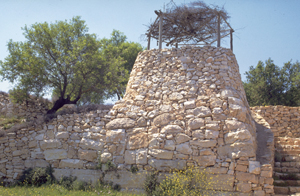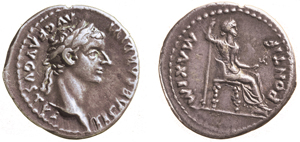The Parable of the Tenants (12:1–12)
He put a wall around it, dug a pit for the winepress and built a watchtower (12:1). Stone walls were erected around vineyards to keep out animals and foragers. The towers provided some shelter and a lookout during the grape harvest. The description of the vineyard has striking parallels to Isaiah 5:2 (LXX). Since the hedge, winepress, and tower have no significance in the later development of the story, these details are only included to recall the context in Isaiah that pictures God’s lavishing care on the vineyard, his people, but meeting only with ingratitude and unfruitfulness (5:1–7). Jesus’ parable is thus an allegory of God’s troubled relationship with Israel. A fragment from Qumran has been interpreted as applying Isaiah 5 to the temple.270 The problem is not a vineyard that yields bad fruit, but tenants who yield no fruit.
VINEYARD AND WATCHTOWER

A vineyard near the tel of Lachish.

A watchtower in the hills of Samaria.
Then he rented the vineyard to some farmers and went away on a journey (12:1). The parable reflects the real world of absentee landlords. Resentment against them was typical, but few would ever dare to behave as the parable’s tenants did.271 In Longus’s novel, Daphnis and Chloe (4.1–14), the master plans to visit the estate where the hero and heroine keep sheep. They work hard to make things as presentable as possible. Daphnis is uneasy about seeing the master who heretofore has been only a name and referred to as the dreaded master. They panic when an enemy vandalizes their garden, assume the master will have them hanged, and pray that he will never come. Then news comes by messenger that their master will arrive in three days but that his son is coming first and will be there the next day. All goes well as Daphnis is commended to the master for doubling his flock.
Then he sent another servant to them (12:4). The word “servant” is a transparent metaphor for the prophets since the Old Testament uses it frequently to describe them.272 God continually sent prophets to Israel (Jer. 7:25–26). Persistent mistreatment of them was proverbial.273
They will respect my son (12:6). Some interpreters debate whether the word “son” would have been interpreted messianically in the first century. Evidence from the Dead Sea Scrolls referring to the Son of God and Son of the Most High lends credence to the probability that “son” would have been understood in a messianic sense by the audience.274
This is the heir. Come, let’s kill him, and the inheritance will be ours (12:7). The son is on a different level than the servants and crucial for a case involving the disputed ownership of a vineyard. The phrase “Come let us kill him” is the same phrase used by Joseph’s brothers in Genesis 37:20a (LXX). It serves to heighten the tenants’ guilt, which is compounded by their failure to give the body a burial. To be refused honorable burial is a powerful image of humiliating punishment in Scripture.275
The stone the builders rejected has become the capstone (12:10). A portion of Psalm 118 was chanted to greet Jesus as he entered Jerusalem (Mark 11:9–10/ Ps. 118:25). It is now invoked to explain that the one who is rejected will be vindicated (Ps. 118:22–23). The block of stone that the builders rejected becomes the keystone—the wedge-shaped stone placed in the top of an arch that locks the others into position. It is the head of the new structure. An Aramaic play on words between “son” (ben) and “stone” (’eben) may lie behind this saying.
Taxes to Caesar (12:13–18)
Pharisees and Herodians (12:13). See comments on 3:6.
Is it right to pay taxes to Caesar or not? (12:14). Judea became a Roman province in A.D. 6 and was subject to the poll tax (or head tax, distinct from the tax on property and customs on articles). The census provided the data (computed in acres and human heads) from which the Romans levied this tax. Its establishment provoked the revolt of Judas of Galilee because it placed God’s own land at the service of foreigners.276 A “yes” answer to Jesus’ question invites the charge of turning traitor to God by endorsing Caesar’s hegemony over the land. It was also an emotionally charged issue since most residents of Palestine knew someone the Romans sold into slavery, executed, or forced off their land by the whirlpool of debt from the spiraling tax burden. A “no” answer, by contrast, invites the charge of sedition.
Bring me a denarius and let me look at it (12:15). By asking for a denarius that he does not possess, Jesus throws them off their guard. In this era, coins served propaganda purposes. Assuming that they show him a Tiberian denarius, the obverse side bore the image of the emperor with the superscription: “TI[berius] CAESAR DIVI AVG[usti] AVGVSTUS.” The reverse had a female figure facing right, seated on a throne, with a crown and holding a scepter in the right hand and a palm or olive branch in the left. The superscription reads: “Pontif[ex] Maxim[us].” The Pharisees and Herodians possess a coin oozing idolatry and blasphemy. It touts Tiberius as a divine or semidivine being as the son of the divine Augustus. The woman is a priestess or the wife of Augustus, Livia, proclaiming the Pax Romana that places all peoples in subjection.277
COINS

Silver denarius with a portrait of the Roman emperor Tiberius (A.D. 14–37).

A coin depicting the emperor Nero (A.D. 54–68).
Give to Caesar what is Caesar’s and to God what is God’s (12:17). This statement places a limit on Caesar’s authority. Those things stamped with Caesar’s image, such as mere coins, belong to him. Those things stamped with God’s image, such as human beings, belong to God. The image that humans are a coin stamped by God’s seal is found in a discussion about idolatry and immorality in the Talmud. Sinful humans misuse the sexual instinct God gives them, resulting in the conception of illegitimate children. God complains about this, “Not enough that the wicked put My coinage to vulgar use, but they trouble Me to set My seal thereon!”278
The Question about the Resurrection (12:18–27)
Then the Sadducees, who say there is no resurrection (12:18). The Sadducees considered the Mosaic directives alone as binding and rejected what they perceived to be theological innovations. Consequently, they did not believe in a resurrection since it does not appear in the Pentateuch.279 Their attitude may be captured in the hymn to honor ancestors in Sirach 44:1–23: The only immortality one can hope for is having posterity and being remembered.280
When the dead rise, they will neither marry nor be given in marriage; they will be like the angels in heaven (12:25). The Sadducees understand resurrection to be only reanimation. Jesus declares that life in heaven should not be confused with life on earth. He compares it to the life of angels, who are immortal, making procreation and therefore marriage unnecessary.
Have you not read in the book of Moses, in the account of the bush (12:26). The reference to the “bush” passage reflects how Scripture was cited before chapter and verse divisions. The point is that the living God will not tie his name to three corpses.
The Question about the Great Commandment (12:28–34)
Of all the commandments, which is the most important? (12:28). One rabbi declared that of the 613 commandments given to Moses, 365 were negative precepts, “corresponding to the number of solar days,” and 248 were positive commandments, “corresponding to the number of members of a man’s body.”281 The Talmud passage goes on to claim that David reduced them to eleven essential principles, Isaiah to six, Micah to three, and Isaiah, again, to two, and Amos to one.282 This discussion reflects the debate over the relative weight of the various commandments. The rabbis divided them up into light and heavy commandments according to three varying criteria: how severe the penalty was for failing to obey them, how great or little the reward for obeying them, or how easy or difficult they were to fulfill.283
Hear, O Israel … (12:29). Jesus identifies as absolute the first line in the Shema (Deut. 6:4), recited morning and evening by devout Jews, which commands exclusive love for God. He adds a second that is on the same order, love of one’s neighbor. Since love is something that is commanded, it has to do with actions rather than feelings.
Well said, teacher (12:32). The teacher of the law assumes he is in a superior position and able to pass judgments on Jesus’ teaching. Jesus, however, is the final arbiter of the law and of who is near or far from the kingdom of God, and he regains mastery by commending his response.
Jesus’ Question about David’s Son (12:35–37)
Psalm 110 was assumed to refer to a Davidic figure who would reign with God’s authority and crush Israel’s enemies. Jesus challenges the views about this abstract figure. Sons may address their fathers as “Lord,” but never vice versa. Therefore, Jesus uses the psalmist’s words to pose a conundrum about himself as the Son of David (Mark 10:47, 48; 11:10).
The Denunciation of the Scribes (12:38–40)
Teachers of the law (12:38). See “Scribes / Teachers of the Law” at 2:7.
They like to walk around in flowing robes (12:38). Jesus attacks the human fondness to seek honor, to parade one’s caste, and to call attention to one’s piety. The long robes refer to the distinctive white linen robes that set them apart from others. They also expect others to show them the greatest respect and greet them as “Rabbi,” “Father,” “Master” (Matt. 23:7–9), or “Good teacher” (Mark 10:17) and to offer them the seats of honor.
They devour widows’ houses (12:40). Widows are a traditional symbol of the helpless in the Old Testament. Widows without male offspring to protect them were particularly vulnerable, and abusing them is sternly denounced in the Old Testament.284
The Widow’s Offering (12:41–44)
Jesus sat down opposite the place where the offerings were put and watched the crowd putting their money into the temple treasury (12:41). Jesus’ presence in the temple began with his condemnation of the buyers and sellers for the animal sacrifices and ends with his commendation of one who sacrifices her all for God. “Opposite the place where the offerings were put” may refer to a special room in the temple or to one of thirteen chests, shaped like a trumpet, that stood around the Court of Women. The verb translated “putting” is the verb “to throw” and suggests throwing something into a chest. The Mishnah mentions shofar-chests labeled for different types of offerings: “new shekel dues,” “old shekel dues” (paid only by males), “bird offerings” (for the purchase of turtle doves), “young birds for whole offerings” (for the purchase of pigeons), “wood” (for burning on the altar), “frankincense,” and “gold for the mercy seat”; six were designated “free-will offerings.”285 The small amount of the widow’s contribution means that her gift can only go to the freewill offering, which goes to the building of the temple (see Ex. 35–36; 1 Chron. 29), or burnt offerings, from which the priests receive the hides.286
But a poor widow came and put in two very small copper coins, worth only a fraction of a penny (12:42). A widow is indeed poor if she has only two lepta. The lepton was a tiny copper coin with the least value of any in circulation in the time of Jesus, about one-eighth of a Roman assarion. The two lepta are said to be worth a quadrans, the smallest Roman coin. Four quadrans equal an assarion which was worth one-sixteenth of a denarius. If a day laborer earned a denarius for a day’s wage (Matt. 20:2), this woman has one-sixty-fourth of that wage. If this is all she has to live on, she is indeed destitute.

BRONZE LEPTA
A horde of lepta and a terra cotta jar in which they were found.
A similar story occurs in later rabbinic literature:
Once a woman brought a handful of fine flour [for a meal offering, Lev. 11:2], and the priest despised her, saying: “See what she offers! What is there to eat? What is there to offer up?” It was shown to him in a dream: “Do not despise her! It is regarded as if she had sacrificed her own life.”287
Jesus does not need a dream vision to recognize the worth of her extraordinary sacrificial giving.